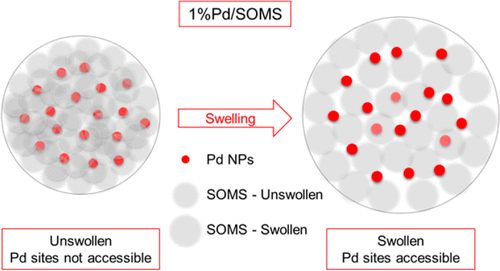当前位置:
X-MOL 学术
›
ACS Catal.
›
论文详情
Our official English website, www.x-mol.net, welcomes your feedback! (Note: you will need to create a separate account there.)
Swellable Organically Modified Silica (SOMS) as a Catalyst Scaffold for Catalytic Treatment of Water Contaminated with Trichloroethylene
ACS Catalysis ( IF 12.9 ) Pub Date : 2018-06-08 00:00:00 , DOI: 10.1021/acscatal.8b01700 Gokhan Celik 1 , Saurabh A. Ailawar 1 , Hyuntae Sohn 1 , Yu Tang 2 , Franklin Feng Tao 2 , Jeffrey T. Miller 3 , Paul L. Edmiston 4 , Umit S. Ozkan 1
ACS Catalysis ( IF 12.9 ) Pub Date : 2018-06-08 00:00:00 , DOI: 10.1021/acscatal.8b01700 Gokhan Celik 1 , Saurabh A. Ailawar 1 , Hyuntae Sohn 1 , Yu Tang 2 , Franklin Feng Tao 2 , Jeffrey T. Miller 3 , Paul L. Edmiston 4 , Umit S. Ozkan 1
Affiliation

|
The properties of a swellable organically modified silica (SOMS) scaffold allowed us to synthesize “smart” catalysts with tunable accessibility of the active sites induced by organic swelling agents. Pd nanoparticles (NPs) deposited inside the swollen matrix of SOMS were shown to be selectively located on the interior surface, a surface which is only available through swelling. Techniques such as near ambient-pressure X-ray photoelectron spectroscopy (NAP–XPS) and cryogenic scanning electron microscopy (SEM) were employed to characterize Pd/SOMS in its swollen as well as unswollen state because their conventional counterparts do not preserve the swollen state of Pd/SOMS during spectral acquisition. The results obtained depicted significant differences between the unswollen and swollen state of Pd/SOMS. The most important difference is that Pd NPs became accessible on the surface after exposure to an organic compound. This indicates that the accessibility of the active sites can be controlled by changing the reaction environment, hence allowing a tunable accessibility induced by organic swelling agents. The effects of the extent of swelling on the catalytic activity were investigated by performing catalytic activity experiments in the presence of an organic swelling agent. Hydrodechlorination (HDC) of trichloroethylene (TCE), an important method of catalytic water abatement, was chosen as a model reaction. The catalytic performance was found to be proportional to the concentration of the organic swelling agent, indicating that the accessibility of active sites is related to the concentration of organic compounds. While the unavoidable reaction product HCl inhibited the commonly used HDC catalyst 1%Pd/Al2O3, 1%Pd/SOMS was able to maintain its rate throughout the reaction under the same conditions, indicating its resistance to the inhibition. Overall, a silica-based catalyst with tunable accessibility of the active sites induced by changes in the reaction environment can have significant implications for heterogeneous catalysis.
中文翻译:

可膨胀有机改性二氧化硅(SOMS)作为催化剂支架,用于催化处理被三氯乙烯污染的水
可膨胀的有机改性二氧化硅(SOMS)支架的特性使我们能够合成“智能”催化剂,并且有机膨胀剂诱导的活性位点具有可调节的可及性。沉积在SOMS溶胀基质内部的Pd纳米颗粒(NPs)显示选择性地位于内表面上,该表面只能通过溶胀来获得。Pd / SOMS处于溶胀和未溶胀状态时,采用了近环境压力X射线光电子能谱法(NAP–XPS)和低温扫描电子显微镜(SEM)来表征,因为它们的常规对等物不能保持溶胀状态光谱采集过程中Pd / SOMS的变化。获得的结果描述了Pd / SOMS的未溶胀状态和溶胀状态之间的显着差异。最重要的区别是,在暴露于有机化合物后,Pd NPs在表面上变得可访问。这表明可以通过改变反应环境来控制活性位点的可及性,因此可以使有机溶胀剂产生可调节的可及性。通过在有机溶胀剂的存在下进行催化活性实验来研究溶胀程度对催化活性的影响。选择三氯乙烯(TCE)的加氢脱氯(HDC)作为催化减水的一种重要方法,作为模型反应。发现催化性能与有机溶胀剂的浓度成正比,表明活性位点的可及性与有机化合物的浓度有关。2 O 3,1%Pd / SOMS能够在相同条件下整个反应过程中保持其速率,表明其对抑制的抵抗力。总体而言,基于二氧化硅的催化剂具有因反应环境的变化而引起的活性位点的可调节可及性,可对非均相催化产生重大影响。
更新日期:2018-06-08
中文翻译:

可膨胀有机改性二氧化硅(SOMS)作为催化剂支架,用于催化处理被三氯乙烯污染的水
可膨胀的有机改性二氧化硅(SOMS)支架的特性使我们能够合成“智能”催化剂,并且有机膨胀剂诱导的活性位点具有可调节的可及性。沉积在SOMS溶胀基质内部的Pd纳米颗粒(NPs)显示选择性地位于内表面上,该表面只能通过溶胀来获得。Pd / SOMS处于溶胀和未溶胀状态时,采用了近环境压力X射线光电子能谱法(NAP–XPS)和低温扫描电子显微镜(SEM)来表征,因为它们的常规对等物不能保持溶胀状态光谱采集过程中Pd / SOMS的变化。获得的结果描述了Pd / SOMS的未溶胀状态和溶胀状态之间的显着差异。最重要的区别是,在暴露于有机化合物后,Pd NPs在表面上变得可访问。这表明可以通过改变反应环境来控制活性位点的可及性,因此可以使有机溶胀剂产生可调节的可及性。通过在有机溶胀剂的存在下进行催化活性实验来研究溶胀程度对催化活性的影响。选择三氯乙烯(TCE)的加氢脱氯(HDC)作为催化减水的一种重要方法,作为模型反应。发现催化性能与有机溶胀剂的浓度成正比,表明活性位点的可及性与有机化合物的浓度有关。2 O 3,1%Pd / SOMS能够在相同条件下整个反应过程中保持其速率,表明其对抑制的抵抗力。总体而言,基于二氧化硅的催化剂具有因反应环境的变化而引起的活性位点的可调节可及性,可对非均相催化产生重大影响。



























 京公网安备 11010802027423号
京公网安备 11010802027423号